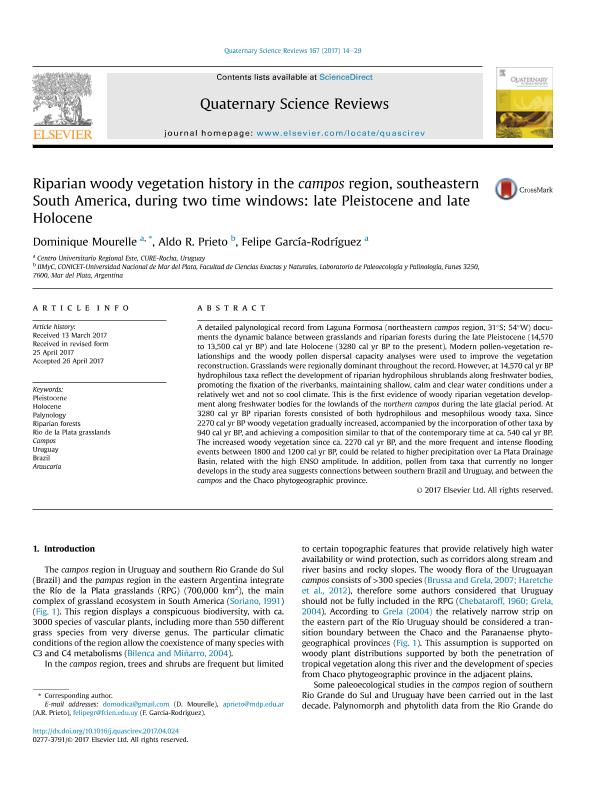Mostrar el registro sencillo del ítem
dc.contributor.author
Mourelle Civano, Dominique

dc.contributor.author
Prieto, Aldo Raul

dc.contributor.author
Garcia Rodriguez, Felipe

dc.date.available
2018-11-20T14:14:03Z
dc.date.issued
2017-07-01
dc.identifier.citation
Mourelle Civano, Dominique; Prieto, Aldo Raul; Garcia Rodriguez, Felipe; Riparian woody vegetation history in the campos region, southeastern South America, during two time windows: late Pleistocene and late Holocene; Pergamon-Elsevier Science Ltd; Quaternary Science Reviews; 167; 1-7-2017; 14-29
dc.identifier.issn
0277-3791
dc.identifier.uri
http://hdl.handle.net/11336/64717
dc.description.abstract
A detailed palynological record from Laguna Formosa (northeastern campos region, 31°S; 54°W) documents the dynamic balance between grasslands and riparian forests during the late Pleistocene (14,570 to 13,500 cal yr BP) and late Holocene (3280 cal yr BP to the present). Modern pollen-vegetation relationships and the woody pollen dispersal capacity analyses were used to improve the vegetation reconstruction. Grasslands were regionally dominant throughout the record. However, at 14,570 cal yr BP hydrophilous taxa reflect the development of riparian hydrophilous shrublands along freshwater bodies, promoting the fixation of the riverbanks, maintaining shallow, calm and clear water conditions under a relatively wet and not so cool climate. This is the first evidence of woody riparian vegetation development along freshwater bodies for the lowlands of the northern campos during the late glacial period. At 3280 cal yr BP riparian forests consisted of both hydrophilous and mesophilous woody taxa. Since 2270 cal yr BP woody vegetation gradually increased, accompanied by the incorporation of other taxa by 940 cal yr BP, and achieving a composition similar to that of the contemporary time at ca. 540 cal yr BP. The increased woody vegetation since ca. 2270 cal yr BP, and the more frequent and intense flooding events between 1800 and 1200 cal yr BP, could be related to higher precipitation over La Plata Drainage Basin, related with the high ENSO amplitude. In addition, pollen from taxa that currently no longer develops in the study area suggests connections between southern Brazil and Uruguay, and between the campos and the Chaco phytogeographic province.
dc.format
application/pdf
dc.language.iso
eng
dc.publisher
Pergamon-Elsevier Science Ltd

dc.rights
info:eu-repo/semantics/openAccess
dc.rights.uri
https://creativecommons.org/licenses/by-nc-sa/2.5/ar/
dc.subject
Araucaria
dc.subject
Brazil
dc.subject
Campos
dc.subject
Holocene
dc.subject
Palynology
dc.subject
Pleistocene
dc.subject
Rio de La Plata Grasslands
dc.subject
Riparian Forests
dc.subject
Uruguay
dc.subject.classification
Otras Ciencias de la Tierra y relacionadas con el Medio Ambiente

dc.subject.classification
Ciencias de la Tierra y relacionadas con el Medio Ambiente

dc.subject.classification
CIENCIAS NATURALES Y EXACTAS

dc.title
Riparian woody vegetation history in the campos region, southeastern South America, during two time windows: late Pleistocene and late Holocene
dc.type
info:eu-repo/semantics/article
dc.type
info:ar-repo/semantics/artículo
dc.type
info:eu-repo/semantics/publishedVersion
dc.date.updated
2018-10-23T14:08:40Z
dc.identifier.eissn
1873-457X
dc.journal.volume
167
dc.journal.pagination
14-29
dc.journal.pais
Estados Unidos

dc.journal.ciudad
Nueva York
dc.description.fil
Fil: Mourelle Civano, Dominique. Consejo Nacional de Investigaciones Científicas y Técnicas; Argentina. Centro Universitario Regional Este; Uruguay
dc.description.fil
Fil: Prieto, Aldo Raul. Consejo Nacional de Investigaciones Científicas y Técnicas. Centro Científico Tecnológico Conicet - Mar del Plata. Instituto de Investigaciones Marinas y Costeras. Universidad Nacional de Mar del Plata. Facultad de Ciencias Exactas y Naturales. Instituto de Investigaciones Marinas y Costeras; Argentina
dc.description.fil
Fil: Garcia Rodriguez, Felipe. Centro Universitario Regional Este; Uruguay
dc.journal.title
Quaternary Science Reviews

dc.relation.alternativeid
info:eu-repo/semantics/altIdentifier/url/http://linkinghub.elsevier.com/retrieve/pii/S0277379117302263
dc.relation.alternativeid
info:eu-repo/semantics/altIdentifier/doi/https://dx.doi.org/10.1016/j.quascirev.2017.04.024
Archivos asociados
